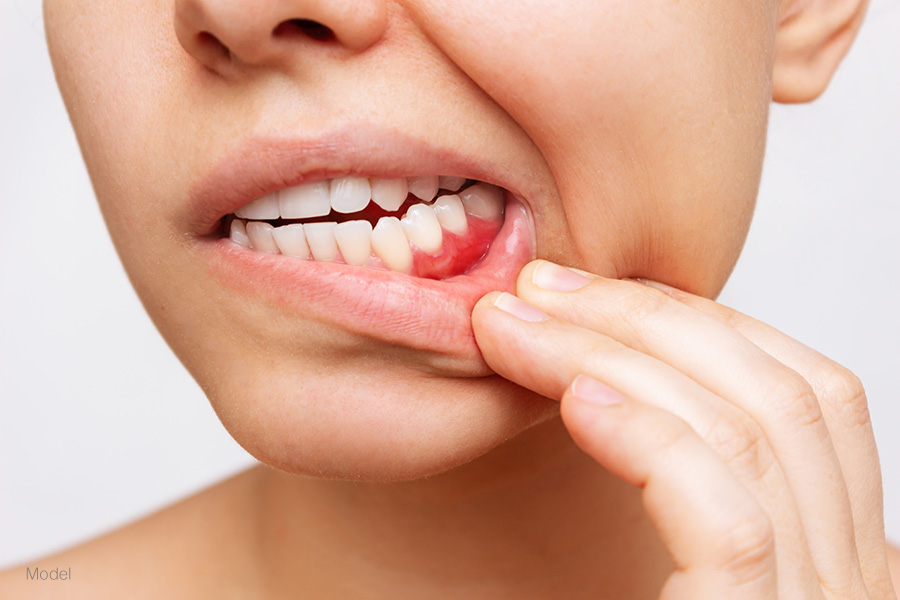When Should You Consider Regenerative Treatments for Gum Disease?
4-Minute Read:
If you suffer from periodontal disease (also known as gum disease), you may struggle with pain, redness, swelling, or bleeding gums. While diligent oral hygiene and regular dental visits help prevent gum disease, you may need more advanced care and treatment.
Gum disease may affect just one tooth or impact your entire mouth. Fortunately, the damage done by periodontal disease is treatable and often reversible. Dr. Salamati provides his patients with several treatment options for all stages of gum disease, designed to keep your smile beautiful and healthy for as long as possible.

What Is Periodontal Disease?
Periodontal disease is the result of infection in the tissues anchoring your teeth in place. The infections occur because a buildup of plaque (bacteria) on your teeth infects and inflames the gum tissue. When gum disease irritates your gums, they swell, causing them to pull away from your teeth.
The loosened gums allow plaque (bacteria) and tartar to spread deeper under your gum line, all the way to the root of your tooth. The formation of bacteria around and below the gum line causes inflammation and bone loss around the tooth and, eventually, tooth loss.
Types of Regenerative Treatments
Periodontal Scaling and Root Planing
Periodontal scaling and root planing may sound scary, but it’s really just a deep cleaning of your teeth.
If you have gum disease, Dr. Salamati may recommend scaling and root planing. After numbing your gums, he inserts a thin tool under the gum line to clean off excess plaque and tartar buildup. This is known as scaling, and it is designed to address the places under your gums unreachable by brushing and flossing.
Root planing goes even deeper to clean out plaque or tartar that has penetrated the root of the tooth, smoothing the surface of the tooth and allowing your gums to heal and reattach. After treatment, your gums may be slightly sore, but the discomfort lessens within a couple of days.
In some cases, Dr. Salamati may prescribe oral systemic antibiotics or antimicrobials administered straight into the periodontal pocket. Both of these treatments help to prevent infection as your gums heal.
Pocket Reduction Surgery
For more advanced cases of periodontal disease, Dr. Salamati may recommend pocket reduction surgery (also called osseous surgery). The goal of this surgery is to remove plaque and tartar from under your gum line, which was not possible to clean completely with the scaling and root planing due to periodontal pockets that are too deep. This surgery also addresses the pockets formed between your teeth and gums created by gum disease.
After administering a local anesthetic, Dr. Salamati gently separates your gums from around the teeth. He then removes the infected tissue, deep cleans the root surface, and reshapes (smooths) the bone damaged by gum disease. In many instances, he is able to perform regenerative therapy to rebuild the bone around the teeth. This allows the roots to be completely free of bacteria and reduces the periodontal pockets to allow improved home care and maintenance of the teeth.
Once the area is treated, Dr. Salamati sutures your gums back into place. As with scaling and root planing, he may prescribe antibiotics or microbial treatments to prevent infection. While you may experience minor discomfort for a few days, this is easily remedied with prescription or over-the-counter pain reducers.
Guided Tissue Regeneration
Guided tissue regeneration is designed to rebuild the bone that has been lost around the teeth as a result of gum disease.
This is performed by ensuring the roots are thoroughly cleaned and placing bone graft material in the area of the bone loss. In some instances, a biologic (Emdogain) is used to enhance regeneration. Finally, a resorbable collagen membrane is placed over the graft material, which compartmentalizes the area to allow the slow-growing bone to regenerate below the gum line.
Over a few months, the membrane dissolves, and the gum tissue attaches to the regenerated and strengthened tooth.
Seeking Treatment for Gum Disease in Beverly Hills, California
If you experience any of the symptoms of gum disease, make an appointment with a dentist as quickly as possible. The sooner you address the problems and seek treatment, the better it is for your teeth and gums.
If you’re looking for the best in dental care and expertise in regenerative treatments for gum disease, contact Dr. Salamati today. Call us at 310-275-1090 for more information or to schedule a consultation.
